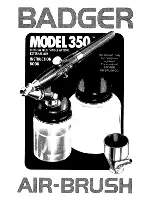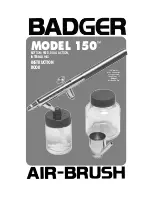
This symbol indicates a hazardous situation, which,
if not not avoided could result in death or serious
injury.
HAZARD: EXPLOSION OR FIRE
Solvent and paint fumes can explode or ignite.
Property damage and/or severe injury can occur.
PREVENTION:
• Provide extensive exhaust and fresh air introduction to
keep the air within the spray area free from accumulation of
flammable vapors.
• Avoid all ignition sources such as static electric
sparks, open flames, pilot lights, electrical
appliances, and hot objects. Connecting or
disconnecting power cords or working light
switches can make sparks.
• Do not smoke in spray area.
• Fire extinguisher must be present and in good working order.
• Use only in a well-ventilated area. Flammable vapors are
often heavier than air and can accumulate along the floor or
ground.
• Follow the material and solvent manufacturer’s warnings and
instructions.
• Do not use materials with a flashpoint below 70°F (21°C).
Flashpoint is the temperature that a fluid can produce
enough vapors to ignite (see coating supplier).
• Plastic can cause static sparks. Never hang plastic to
enclose the spray area. Do not use plastic drop cloths when
spraying flammable materials.
HAZARD: EXPLOSION HAZARD DUE TO
INCOMPATIBLE MATERIALS
Will cause property damage or severe injury.
PREVENTION:
• Do not use materials containing bleach or chlorine.
• Do not use halogenated hydrocarbon solvents such
as bleach, mildewcide, methylene chloride and
1,1,1--trichloroethane. They are not compatible with
aluminum.
• Contact your coating supplier about the compatibility of
material with aluminum.
HAZARD: HAZARDOUS VAPORS
Paints, solvents, insecticides, and other materials
can be harmful if inhaled or come in contact with the
body. Vapors can cause severe nausea, fainting, or
poisoning.
PREVENTION:
• Use a respirator or mask if vapors can be
inhaled. Read all instructions supplied with the
mask to be sure it will provide the necessary
protection.
• Wear protective eyewear.
• Wear protective clothing as required by coating
manufacturer.
English
2
Important Safety Information
·
Read all safety information before operating
the equipment. SAVE THESE INSTRUCTIONS.
To reduce the risks of fire or explosion, electrical shock and the injury to persons, read and understand all instructions included in
this manual. Be familiar with the controls and proper usage of the equipment.
HAZARD: ELECTRIC SHOCk HAZARD
May cause severe injury.
PREVENTION:
• Keep electrical cord plug and spray gun trigger free
from paint and other liquids. Never hold the cord at plug
connections to support the cord. Failure to observe may
result in an electrical shock.
HAZARD: GENERAL
Can cause severe injury or property damage.
PREVENTION:
• Read all instructions and safety precautions before operating
equipment.
• Follow all appropriate local, state, and national codes
governing ventilation, fire prevention, and operation.
• The United States Government Safety Standards have
been adopted under the Occupational Safety and Health
Act (OSHA). These standards, particularly part 1910 of
the General Standards and part 1926 of the Construction
Standards should be consulted.
• Use only manufacturer authorized parts. User assumes all
risks and liabilities when using parts that do not meet the
minimum specifications and safety devices of the turbine
manufacturer.
• Power cord must be connected to a grounded circuit.
• All swivels, guns and accessories must be rated at or above
10 PSI.
• Do not spray outdoors on windy days.
• Wear protective clothing to keep paint off skin and hair.
• Never aim spray gun at any part of the body.
Household use only. Intended for indoor/outdoor use
ONLY with materials having flashpoint above 70ºF (21ºC).
Important Electrical Information
NOTICE -
Use only a 3-wire extension cord that has a 3-blade
grounding plug and a 3-slot receptacle that will accept the plug on
the product. Make sure your extension cord is in good condition.
When using an extension cord, be sure to use one heavy enough
to carry the current your product will draw. An undersized cord
will cause a drop in line voltage resulting in loss of power and
overheating. A 14 or 12 gauge cord is recommended (see chart
below). If an extension cord is to be used outdoors, it must be
marked with the suffix W-A after the cord type designation. For
example, a designation of SJTW-A would indicate that the cord
would be appropriate for outdoor use.
Minimum gauge for extension cords
Cord length (feet)
Voltage
Ampere
rating
range
2 - 3
120V 25-50 100 150 200 250 300 400 500
18
16
14
14
12
12
10
10



































